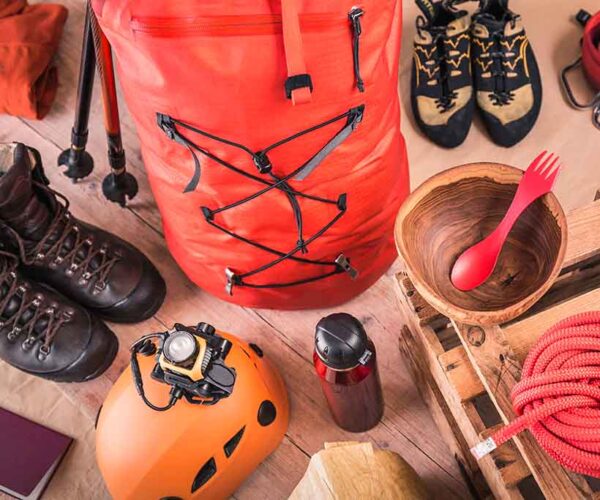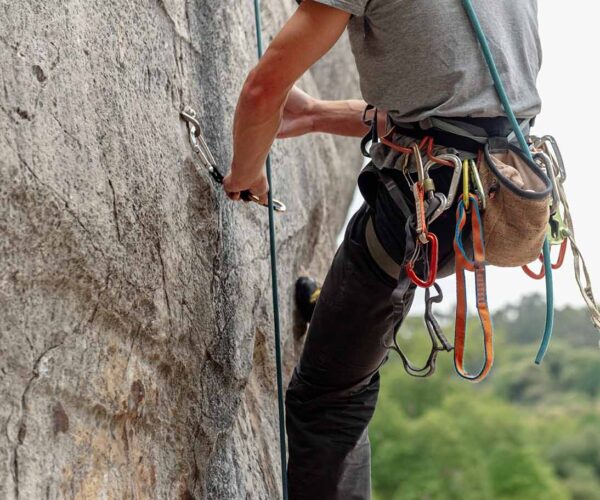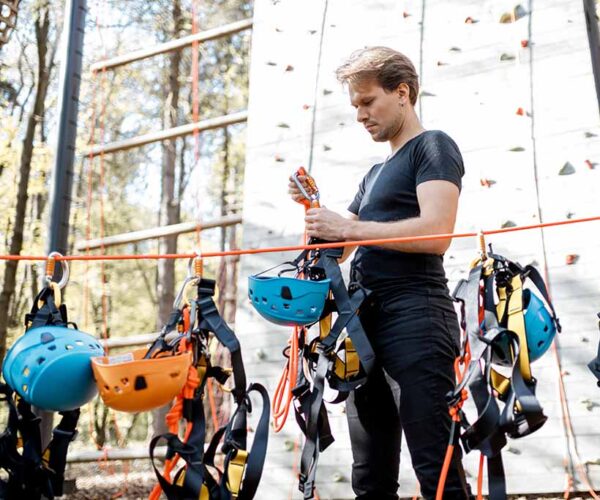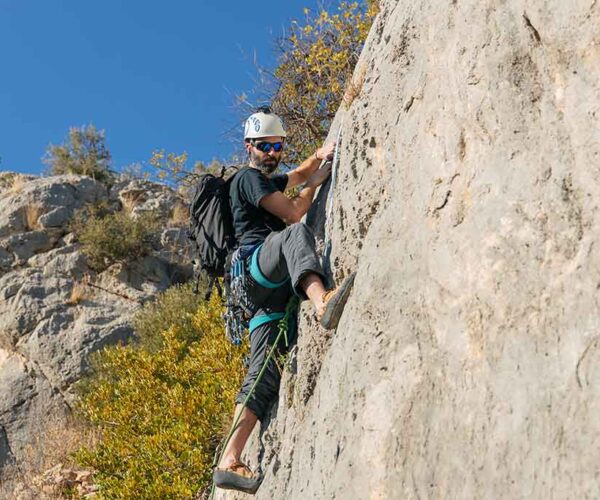Planning your first overseas climbing trip? Or maybe you’re a regular on the UK crags, ready to explore somewhere new on your own terms. Travelling to climb is exciting, new rock, new challenges, and often, better weather, but it comes with a few more logistics than your average day out at your local climbing wall.
This guide is all about helping you prepare for climbing outdoors abroad. Whether you’re heading to sunny sport routes in Spain, bouldering in Switzerland, or eyeing up a trad adventure in the US, we’ll cover what gear you need, how to fly with it, what you can rent, and the key things to know when climbing self-guided in another country.
We’ll also highlight important regulations, like permits or seasonal closures, that vary from place to place and share tips on how to connect with local climbers and communities. Because while gear matters, good info and local beta can make all the difference on your trip.
Climbing equipment - What you really need

For beginners
If you’re just starting out, don’t stress—you don’t need to buy every shiny bit of kit just yet. Here’s a solid starter pack:
- Climbing shoes: A snug fit is essential, but they don’t need to be painful.
- Harness: Look for comfort and adjustability.
- Helmet: Always wear one, even on sport routes.
- Chalk bag: Sweaty palms? Chalk is your best mate.
If you’re heading somewhere with easy rental options or you’re joining a guided trip, you may not need to bring much more. Just double check what’s provided.
For intermediate to experienced climbers
If you’ve got a few climbs under your belt and are planning to go self-guided, you’ll likely want more of your own gear:
- Quickdraws: Essential for sport climbing.
- Climbing rope: A 60m or 70m rope is standard. Check guidebooks for length requirements.
- Belay device and locking carabiners: Make sure you’re familiar with your setup.
- Trad gear: Nuts, cams, slings – if you’re venturing onto trad or mixed terrain.
- Climbing shoes: Choose depending on the type of climbing. Aggressive shoes for steep sport routes, more supportive shoes for trad or multi-pitch.
- Mountaineering boots and crampons: If your trip involves alpine terrain, glacier travel, or icy approaches, these are essential. Make sure boots are crampon compatible.
- Approach shoes: Great for scrambling and walking to remote crags.
- Climbing backpacks: Look for lightweight, durable packs with gear loops or rope carry systems. Sizes between 30L–45L are usually ideal.
- Crash pad: A must-have for bouldering trips. Consider a larger pad or pairing with a travel-sized one for better coverage.
- Slackline: While not essential, a slackline can be a fun way to rest and stay loose on rest days or at the crag campsite.
- Personal anchor system or daisy chain: Useful for cleaning anchors or multi-pitch belays.
- Headtorch: Critical for early starts, long approaches, or finishing climbs in the dark.
Essentials for everyone
Regardless of level, these are the most important items of rock climbing equipment to have with you:
- Helmet
- Harness
- Belay device
- Chalk and chalk bag
- Appropriate shoes
- Climbing rope (if not renting)
How much does climbing gear cost?

Climbing gear can be a bit of an investment, but you can build up over time. Here’s a rough idea:
- Shoes – £60–£130
- Harness – £50–£90
- Helmet – £40–£80
- Belay device + carabiner – £30–£60
- Rope – £100–£200
- Quickdraw set (10–12) – £100–£180
Top tip: Join a local climbing club or community—they often have discounts, second-hand gear, or gear libraries for borrowing.
What is the most expensive climbing equipment?
While many pieces of climbing kit are affordable on their own, some items really push the budget—especially if you go for top-of-the-line models:
- Climbing ropes – Top-tier dry-treated or bi-pattern ropes can cost up to £250 or more. They’re worth it for alpine or wet conditions, where durability and safety are crucial.
- Trad gear – A full trad rack (cams, nuts, hexes, slings) can set you back £500–£800 easily. Cams in particular are pricey, averaging £60–£80 each.
- Crash pads – Larger, high-quality pads with extra padding and durable hinges can cost upwards of £250.
- Mountaineering boots – Technical mountaineering boots (especially insulated, crampon-compatible pairs) often start around £300 and can go well over £500.
- Crampons and ice tools – A good pair of crampons is around £100–£180, while ice axes or tools for technical climbing can run £150–£250 each.
- Climbing backpacks – Specialist packs with advanced carry systems and lightweight materials can cost £120–£200.
These are the kinds of gear that are long-term investments. If you’re climbing in more demanding environments, it’s worth spending a bit more for safety, performance, and comfort.
Renting climbing equipment abroad

Not keen on lugging your entire rack across continents? Renting gear is a perfectly good option, especially if you’re travelling light. However, whilst you might find rental options in popular climbing spots you may not find them accessible in locations off-the-beaten track.
What can you rent? Usually: shoes, helmets, harnesses, ropes, crash pads, quickdraws. Trad gear is less commonly rented.
Where to rent? Local climbing shops, gyms, or guide companies. Look for reviews or recommendations online.
What to check: Make sure rental gear is in good condition. Avoid frayed ropes or overly worn shoes.
Renting is great for shorter trips, or if you want to try a new discipline (like bouldering or via ferrata) without committing to the gear.
Taking climbing equipment on a flight
Packing climbing gear for a flight can feel like a puzzle. Here’s how to avoid any last-minute airport drama:
- Pack your rope and metal gear in your checked luggage – Quickdraws and carabiners can cause delays at security.
- Climbing shoes and chalk bag can go in your hand luggage – But seal that chalk bag or it’ll coat everything.
- Use a rope bag or stuff sack – It keeps things tidy and protects your rope.
- Label your gear – Especially if you’re sharing with friends.
Always check with your airline about weight limits and sporting equipment policies. Some allow extra baggage for outdoor gear. There will also be some gear you cannot take into the cabin and will have to be checked in as a hold luggage.
Climbing self-guided abroad: Can you and should you?

Yes, you absolutely can – but it takes more planning and responsibility. Here’s what to think about:
Know the area
Do thorough research. Invest in a reputable guidebook and consider using local apps or forums. Check access notes, route quality, and seasonal restrictions.
Check local regulations
Some areas require permits, registration, or have specific climbing hours. In protected areas or national parks, there may be restrictions on bolting or even total bans on climbing.
Access and ethics
Respect local customs and crag etiquette. Some areas may have quiet zones, bans on chalk or specific gear use, or expectations about waste management. What’s normal in the UK might not be elsewhere, so it pays to read up and observe others.
Climb with caution
Climbing abroad often means unfamiliar rock types, bolting styles, or grading systems. Start on easier routes and work your way up.
Considerations for self-guided climbing trips
Navigation
Learn to read topos, approach notes, and traditional maps. GPS apps can help, but mobile signal isn’t guaranteed in rural or mountainous areas.
Emergency plans
Know the local emergency number (e.g. 112 in Europe). Carry a fully charged phone, a power bank, and consider a basic first-aid kit. In remote areas, a GPS beacon or emergency communicator might be a smart addition.
Insurance
Make sure your policy specifically covers outdoor climbing, rescue, and repatriation. Many standard travel policies exclude climbing over certain heights or on natural rock. It’s also wise to insure high-value gear in case of theft, loss or damage.
Weather and rock type
Rock types vary across regions, affecting friction, protection placement, and even how holds feel. Be prepared for sudden weather shifts, especially in the mountains. Bring layers, waterproofs, and check daily forecasts.
Partner skills
If you’re climbing with new partners abroad, take time to check each other’s experience and communication. Establish safety checks, belay commands, and backup plans before setting off.
Joining a local guide or group for a day can be a great way to ease in and get the lay of the land.
Final tips for a smooth climbing trip
- Pack light, but smart – Multipurpose gear can save space and weight.
- Join local forums or Facebook groups – There’s a wealth of knowledge to be found here including useful tips on specific areas and groups and partners to join up with.
- Make a checklist – Don’t forget the sun cream, tape, or that crucial extra carabiner. For more information read our rock climbing packing checklist here.
Going abroad to climb is one of the best ways to experience new places and climbing communities around the world. With a little prep, the right gear, and a solid plan, you’re all set to send.
Get rock climbing insurance from SportsCover Direct
Climbing is all about pushing your limits and making the most of every adventure. To keep your focus on the fun—and not the what-ifs—it’s worth sorting a solid rock climbing insurance policy before you go. It’s a smart way to protect yourself, your gear, and your plans, so you can climb with confidence wherever the journey takes you.
SportsCover Direct’s specialist Rock Climbing Insurance offers cover for up to 7,000m. You can select from three policy options, including our Travel Insurance which includes going abroad either for leisure or to compete. You’ll benefit from financial cover for medical and repatriation fees, as well as being protected in the event your trip is cancelled or impacted in some way.
There’s also our Travel Insurance Bolt-On, in case you already have a policy for going overseas that doesn’t cover rock climbing. Lastly, the Sports Accident policy gives you peace of mind if an incident occurs, including personal liability and protection for loss of earnings.
Get an instant quote for your climbing requirements. If you have any questions, contact our friendly team.
This blog has been created as general information and should not be taken as advice. Make sure you have the correct level of insurance for your requirements and always review policy documentation.